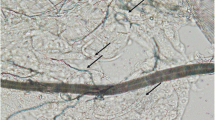Abstract
Temperature was found to be a major factor affecting the development of Dipylidium caninum and the presence of a host reaction of adult Ctenocephalides felis felis to D. caninum. Adult fleas reared at 30–32‡ C contained fully developed metacestodes when they emerged from their cocoons. However at lower temperatures, D. caninum could not complete development until the flea hosts had spent some time on their mammalian hosts. It was the surface temperature of the mammals (31–36‡ C) and not the fleas' blood meals which resulted in the metacestodes completing their development. This development of D. caninum was therefore independent of the flea development. At 20‡ C, a larger and more prolonged host reaction was mounted than at higher temperatures. The larval flea diet had a small effect on the subsequent cestode development and the adult flea's reaction to it.
Similar content being viewed by others
References
Buxton PA, Mellanby K (1934) The measurement and control of humidity. Bull Entomol Res 25:171–175
Chen HT (1934) Reactions of Ctenocephalides felis to Dipylidium caninum. Z Parasitenkd 6(5): 603–637
Collin WK (1970) Electron microscopy of postembryonic stages of the tapeworm Hymenolepis citelli. J Parasitol 56:1159–1170
Flanders JE (1937) Starvation of developing parasites as an explanation of immunity. J Econ Entomol 30:970–971
Freeman RS (1970) Terminology of cestode development. J Parasitol 56:106–107
Giusti De DL (1949) The life cycle of Leptorhynchoides thecatus (Linton), an acanthocephalan of fish. J Parasitol 35:437–460
House HL, Barlow JS (1961) Effects of different diets of a host, Agria affinis (Fall.) (Diptera. Sarcophagidae) on the development of a parasitoid, Aphaereta pallipes (Say) (Hymenoptera: Braconidae). Can Entomol 93:1041–1044
Joseph SA (1974) Ctenocephalides felis orientis Jordan, 1925 as an intermediate host of the dog tapeworm Dipylidium caninum (Linn 1758) Railliet 1892. Cheiron 3:70–75
Lackie AM (1976) Evasion of the haemocytic defence reaction of certain insects by larvae of Hymenolepis diminuta (Cestoda). Parasitology 73:97–107
Lie KJ, Heyneman D (1975) Studies on the resistance in snails: a specific tissue reaction to Echinostoma lindoense in Biomphalaria glabrata snails. Int J Parasitol 5:621–625
Marshall AG (1967) The cat flea, Ctenocephalides felis felis (Bouché 1835) as an intermediate host for cestodes. Parasitology 57:419–430
Nappi AJ, Streams FA (1969) Haemocytic reactions of Drosophila melanogaster to the parasites Pseudocoila mellipes and P. bochei. J Insect Physiol 15:1551–1566
Pesson B, Leger N (1978) Hymenolepis nana var fraterna (Cestoda: Hymenolepididae) chez Leucophaea maderae (Dictyoptera: Blattidae): L'expression du conflit hÔte-parasite apres inhibition expérimentale de la réaction hémocytaire. Ann Parasitol Hum Comp 53:147–154
Pesson B, Leger N, Bouchet P (1978) Le développement du cysticercoide d'Hymenolepis nana var fraterna (Cestoda: Hymenolepididae) dans lar cavité générale de Tenebrio molitor (Coleoptera: Tenebrionidae) et de Leucophaea maderae (Dictyoptera: Blattidae). Ann Parasitol Hum Comp 53:155–161
Pugh RE (1985) Dipylidium caninum in intermediate hosts: with special reference to the hosts' susceptibility to infections. Ph.D thesis University of Queensland, p 209
Pugh RE, Moorhouse DE (1985) Factors affecting the development of Dipylidium caninum in Ctenocephalides felis felis (Bouché 1835). Z Parasitenkd 71:765–775
Salt G (1963) The defence reactions of insects to metazoan parasites. Parasitology 53:527–642
Schiller EL (1959) Experimental studies on morphological variation in the cestode genus Hymenolepis. I. Morphology and development of the cysticercoid of H. nana in Tribolium confusum. Exp Parasitol 8:91–118
Solomon ME (1951) Control of humidity with potassium hydroxide, sulphuric acid or other solutions. Bull Entomol Res 42:543–554
Solomon ME (1957) Cobalt papers and colour standards for humidity estimates. Bull Entomol Res 48:489–506
Soltice GE, Arai HP, Scheinberg E (1971) Host-parasite interactions of Tribolium confusum and T. castaneum with Hymenolepis diminuta. Can J Zool 49:265–273
Taylor A (1935) Experimentally induced changes in the cell complex of the blood of Periplaneta americana (Blattidae: Orthoptera). Ann Entomol Soc Am 28:135–145
Ubelaker JE, Cooper N, Allison VF (1970a) The fine structure of the cysticercoid of Hymenolepis diminuta. I Outer wall of the capsule. Z Parasitenkd 34:258–270
Ubelaker JE, Cooper N, Allison VF (1970b) Possible defensive mechanism of H. diminuta cysticercoids to hemacytes of beetle, Tribolium confusum. J Invertebr Pathol 16:310–312
Venard CE (1938) Morphology, bionomics and taxonomy of the cestode, Dipylidium caninum. Ann NY Acad Sci 37:273–328
Voge M (1959) Sensitivity of developing Hymenolepis diminuta larvae to high temperature stress. J Parasitol 45:175–181
Voge M, Turner JA (1956) The effect of different temperatures on the development of Hymenolepis diminuta (Cestoda: Cyclophyllidea) in Tribolium confusum. J Parasitol Suppl 42:31
Walker I (1959) Die Abwehrreaktion des Wirtes Drosophila melanogaster gegen die zoophage Cynipide Pseudocoila bochei Weld. Rev Suisse Zool 66:569–632
Wardle R, McLeod J (1952) The zoology of tapeworms. University of Minnesota Press, Mineapolis
Wittig G (1963) The pathology of insect blood cells: a review. Am Zool 2:257–273
Yasuda F, Hashiguchi J, Nishikawa H, Wattanabe S (1968) Studies on the life history of Dipylidium caninum (Linnaeus 1758). Bull Nippon Vet Zootech Coll 17:27–32
Zimmerman HR (1937) Life history studies on cestodes of the genus Dipylidium from the dog. Z Parasitenkd 9:717–729
Author information
Authors and Affiliations
Rights and permissions
About this article
Cite this article
Pugh, R.E. Effects on the development of Dipylidium caninum and on the host reaction to this parasite in the adult flea (Ctenocephatides felis felis). Parasitol Res 73, 171–177 (1987). https://doi.org/10.1007/BF00536475
Accepted:
Issue Date:
DOI: https://doi.org/10.1007/BF00536475




